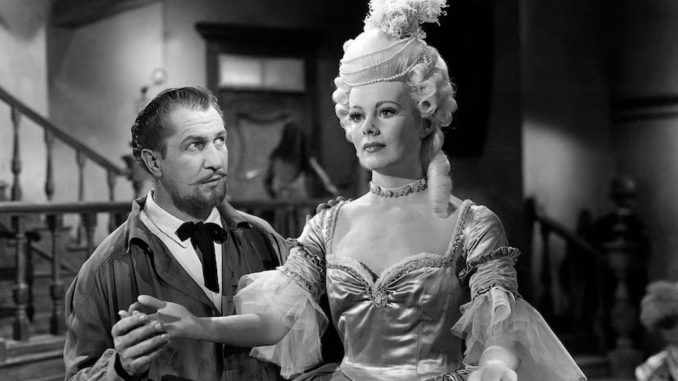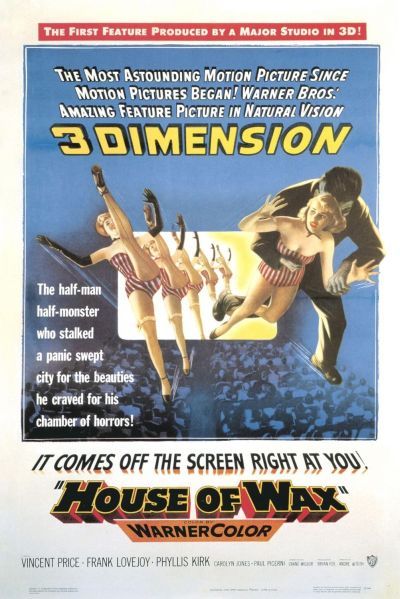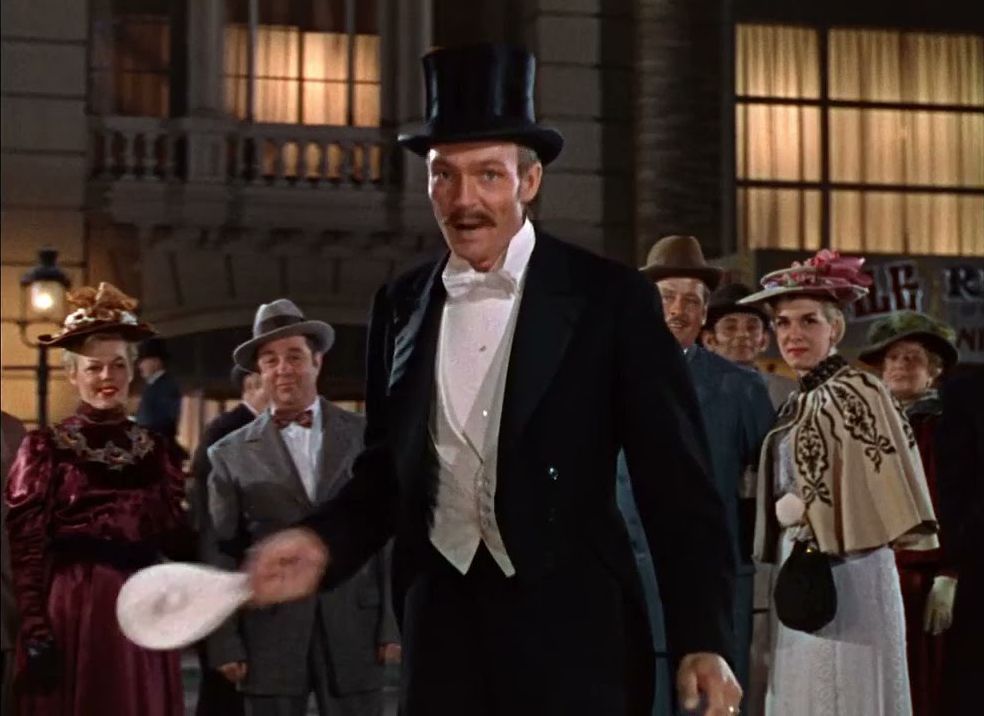
Rating: B
Dir: André De Toth
Star: Vincent Price, Frank Lovejoy, Phyllis Kirk, Carolyn Jones
The history of cinema is littered with gimmicks, designed to go beyond the standard viewing experience and so, lure additional ticket sales. AromaRama. Percepto. Sensurround. All have come, and most have gone as quickly. The one which has stuck around is 3-D, and it owns a longer history than you might think. 3-D dates back over a century to a largely forgotten film called The Power of Love, released in September 1922. Using the red/green system, it came with two endings, and you could pick the one you wanted to see, by closing the other eye. It wasn’t a success: the 3-D version received almost no release, with both it and the 2-D version now considered lost.
It took thirty years for the format to catch on properly, beginning with 1952’s Bwana Devil, advertised with the tagline “A LION in your lap! A LOVER in your arms!” Despite the presence of future star Robert Stack, this set the standard for the medium, by blowing chunks, and was followed in quick succession by a slew of imitators. Most were as good as you would expect from titles like Cat-Women of the Moon, or I Was a Burlesque Queen. The latter was actually a greater con than it sounds. It was nothing more than a retitling of a 1947 comedy under the far less salacious title, Linda, Be Good, into which 3-D footage of a line of burlesque dancers had been spliced by producer Sidney W. Pink.
 Occasionally one would sneak through with something of merit. For example, 1953’s Arena was made in Tucson, and directed by Richard Fleischer, who’d go on to much better things, including Fantastic Voyage and Soylent Green, before returning to the medium thirty years later for Amityville 3-D. Arena provided a very early role for Lee Van Cleef too. Another Arizona-set feature, It Came From Outer Space, also bucked the trend by being decent, and remains well-regarded. For the problem with most 3D films is, to take full advantage of the medium, you need to be less than subtle about your photography, and the movie consequently ends up being about the gimmick, with the plot or characters almost inevitably suffering as a result.
Occasionally one would sneak through with something of merit. For example, 1953’s Arena was made in Tucson, and directed by Richard Fleischer, who’d go on to much better things, including Fantastic Voyage and Soylent Green, before returning to the medium thirty years later for Amityville 3-D. Arena provided a very early role for Lee Van Cleef too. Another Arizona-set feature, It Came From Outer Space, also bucked the trend by being decent, and remains well-regarded. For the problem with most 3D films is, to take full advantage of the medium, you need to be less than subtle about your photography, and the movie consequently ends up being about the gimmick, with the plot or characters almost inevitably suffering as a result.
There’s no denying, House of Wax occasionally falls into this category. Most famously is the paddle-ball scene (below), courtesy of vaudeville performer Reggie Rymal. As a shameless, entirely gratuitous demonstration of 3-D, it can hardly be surpassed. When Chris asked what film we were watching for 1953, I only had to mime hitting a paddle-ball, and she immediately figured it out. The can-can scene is a bit obvious too. What’s ironic, is director De Toth was blind in one eye, having lost its sight in a childhood incident, and so was physically unable to experience his film as intended. Perhaps this is why, like all the better 3-D films, House of Wax is one which can be enjoyed whether you watch it that way, or in regular format.
It should probably be considered as Price’s breakthrough role, into the horror genre he would dominate in the US for much of the following decade or more. His presence elevates proceedings above the likes of The Charge at Feather River, and the film goes into another gear whenever he’s on screen – though that may be less than you expect. It begins with a spat between Professor Henry Jarrod (Price) and his partner in their wax museum, Matthew Burke, who wants to cash out quickly. Burke burns the place down for insurance, with Jarrod still inside. presumed dead. However, after Burke collects, he is “suicided” by a disfigured man. Others involved also perish, including Burke’s fiancée Cathy (Jones, also in Invasion of the Body Snatchers), before Jarrod returns, albeit confined to a wheelchair and unable to sculpt his figures.
He now has assistants to do that for him: mute sidekick Igor is played by one “Charles Buchinsky”, who’d shortly Anglicize his surname to Bronson. The Professor’s new show is a hit – cue gratuitous paddle-ball promotion. However, Cathy’s best friend, Sue Allen (Kirk) notices the really strong resemblance, down to a single pierced ear, of Jarrod’s Joan of Arc to her deceased pal. She tells Detective Tom Brennan (Lovejoy), who gradually realizes there is indeed something weird going on at Jarrod’s establishment. The sculptor, meanwhile, has discovered Sue is the ideal “model” for his new Marie Antoinette (top)- whether she wants to be or not. For Jarrod has abandoned sculpting, and now just dips real people in wax to make his creations.
 Despite its age, there are still some effective frights to be found here. Sue creeping around the deserted museum is still going to get the hairs on the back of my next standing up, and when she knocks off Jarrod’s mask, revealing the disfigured monster beneath, I genuinely let out an exclamation. The concept is nifty too, loosely adapted from 1933’s Mystery of the Wax Museum, and you can see why this was chosen for a (loose) remake, over fifty years later in 2005. [Despite the presence of Paris Hilton, the new version is not terrible: it does its own thing, and Paris’s death – oh, c’mon, that’s not a spoiler! – is memorable, by any standards] It does feel weird having an intermission in the middle of a 88-minute film, but that was a necessity, to give the projectionist a chance to change both reels used for the 3-D process.
Despite its age, there are still some effective frights to be found here. Sue creeping around the deserted museum is still going to get the hairs on the back of my next standing up, and when she knocks off Jarrod’s mask, revealing the disfigured monster beneath, I genuinely let out an exclamation. The concept is nifty too, loosely adapted from 1933’s Mystery of the Wax Museum, and you can see why this was chosen for a (loose) remake, over fifty years later in 2005. [Despite the presence of Paris Hilton, the new version is not terrible: it does its own thing, and Paris’s death – oh, c’mon, that’s not a spoiler! – is memorable, by any standards] It does feel weird having an intermission in the middle of a 88-minute film, but that was a necessity, to give the projectionist a chance to change both reels used for the 3-D process.
Like many now cult horror films, House of Wax was largely hated at the time: The New Yorker review said it “set the movies back about forty-nine years.” You can certainly see shades of some of Price’s subsequent work present here. The Abominable Dr. Phibes might be the most obvious, in terms of “disfigured, mad artist seeks revenge”, though the vengeance aspect is disposed of relatively quickly here. He’d star in another gimmick movie later in the decade, with The Tingler, and his Gothic performance feels at points like it came from Phantom of the Opera. It’s easy to understand why Roger Corman would peg Price to star in his Edgar Allen Poe adaptations.
This article is part of our October 2025 feature, 31 Days of Vintage Horror.
